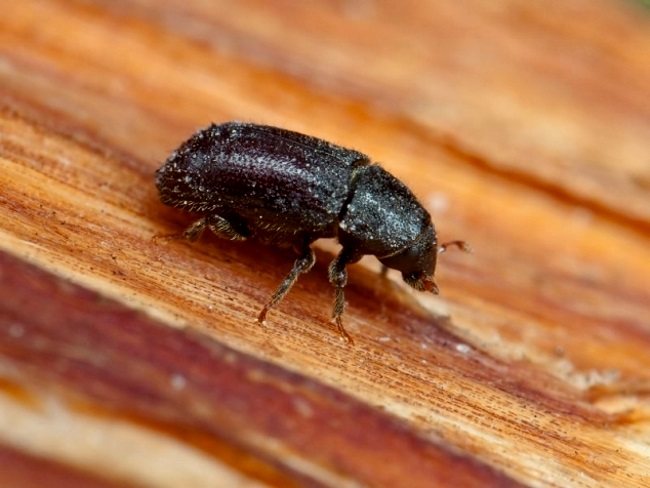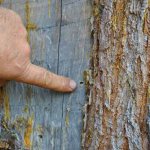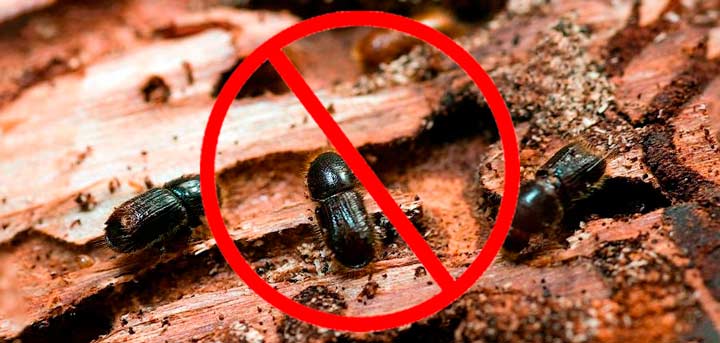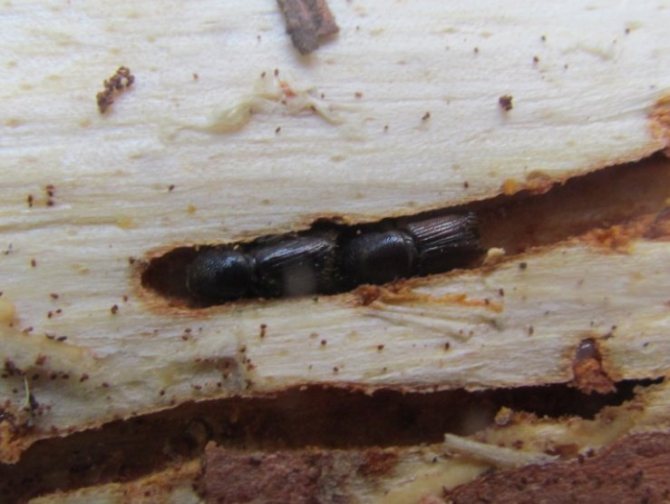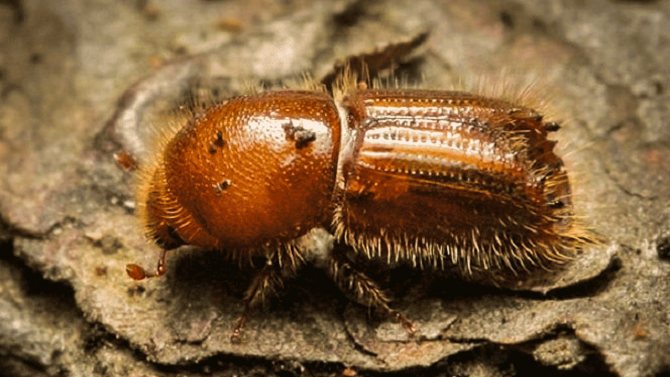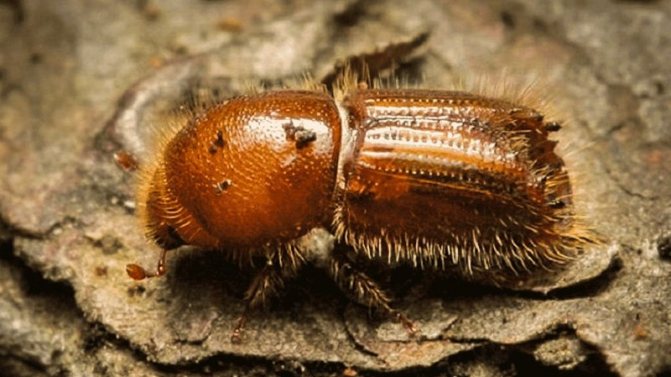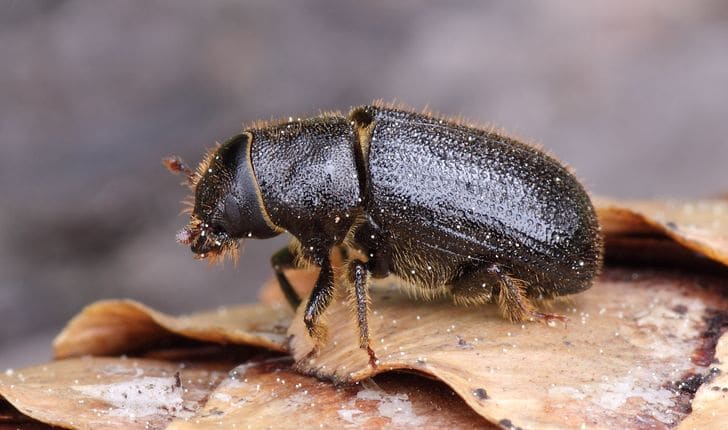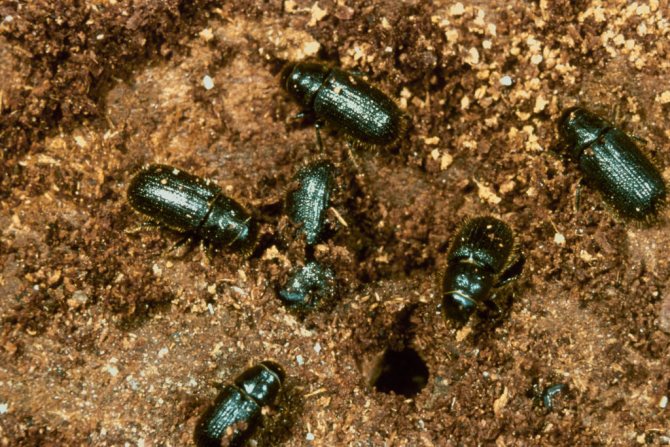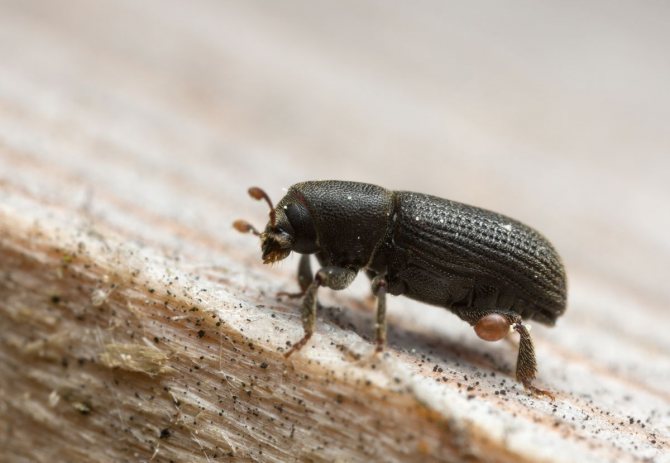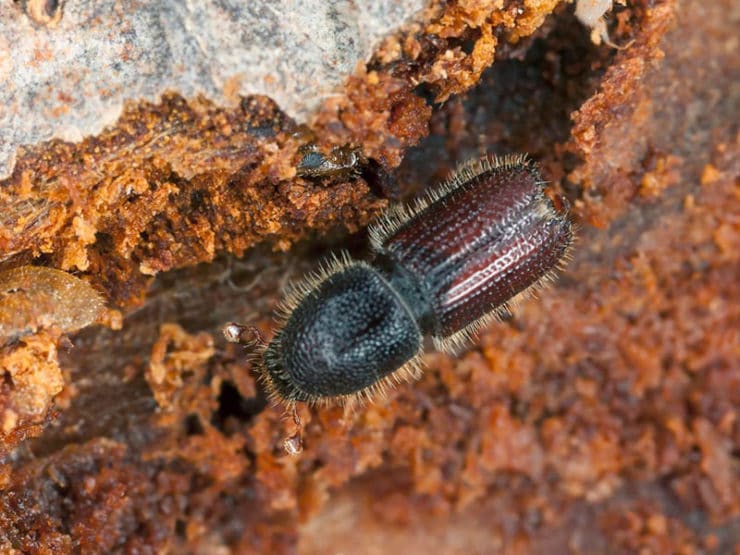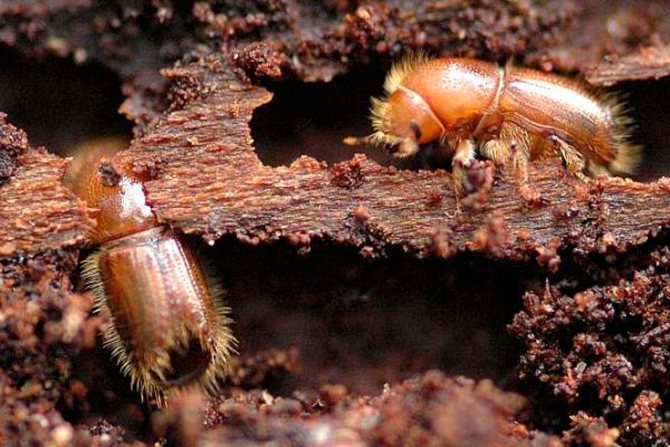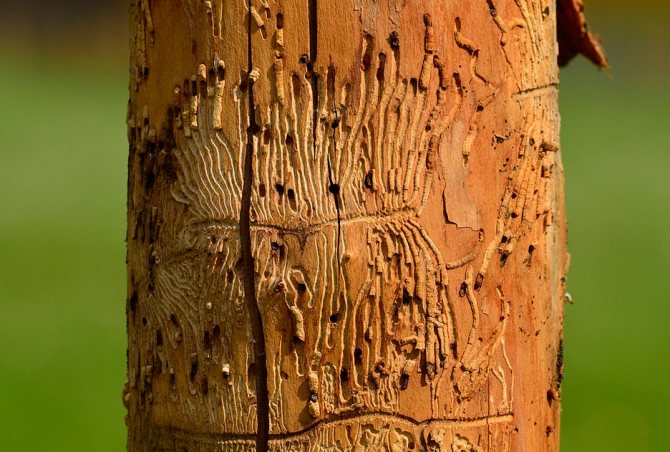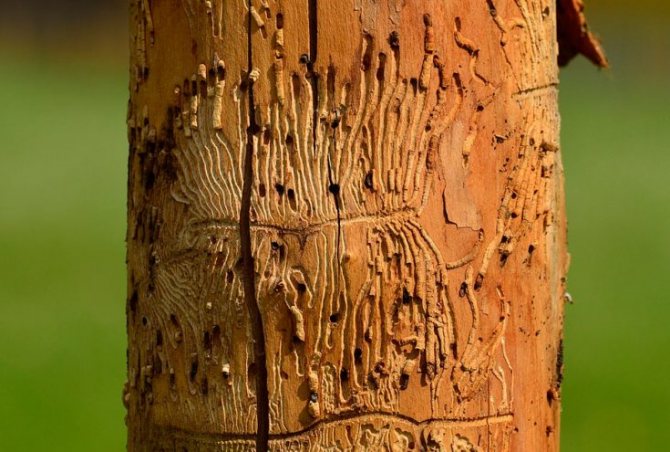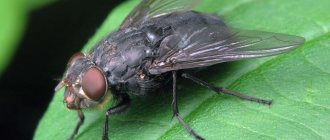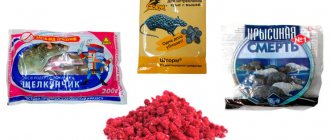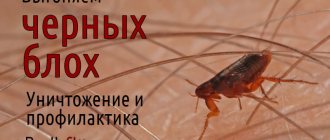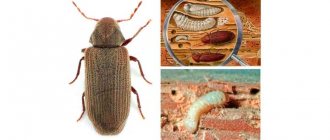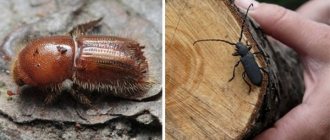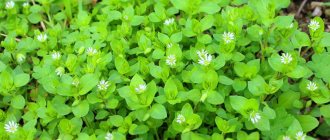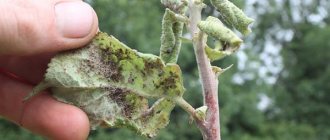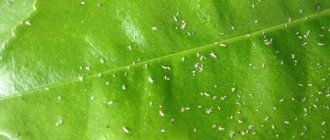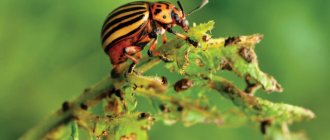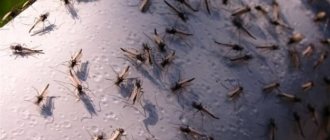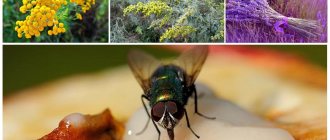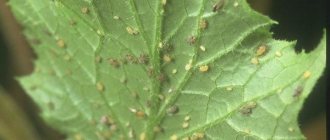29.01.2020
A small bark beetle or, as it is called, a grinder can bring a lot of trouble to people. In a short period of time, he is capable of causing damage to household or forestry, destroying a huge number of trees and turning them into dust. Having settled in a dwelling, he can "eat" from the inside not only furniture, but all of your entire house. How to get rid of a dangerous insect?
- Description of bark beetles
- Danger of the bark beetle
- Fighting the bark beetle in the house
- Fighting the bark beetle in the garden
Bark beetle in the garden
If you notice that oval holes and the so-called wood flour have appeared on the garden trees, then there is every reason to assume that bark beetles have settled in them. Conifers have a natural defense mechanism - they fill the gnawed passages with resin. Stonewood trees are protected in a similar way, and the beetle can be identified by gum flow on the trunks.
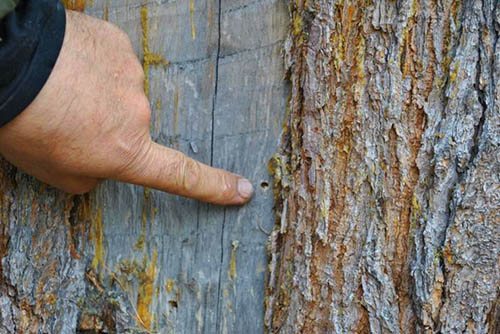
Naturally, the disease is easier to prevent than to cure, so all garden owners are advised to regularly treat plantings with protective agents.
Bark beetle remedies for pretreatment of trees and seedlings:
- "Lepidocide";
- "Bitoxibacillin";
- Boverin.
- "Vectra 3D";
- Aktara;
- "Calypso";
- "Confidor".
Adult plants must be sprayed after flowering, when the swarming period begins for the bark beetle, and repeat the procedure after 2 weeks.
It is important to treat the tree completely, including the trunk, branches and all leaves. Due to the high toxicity of drugs, personal protective equipment should be used - respirator, gloves, goggles, etc.
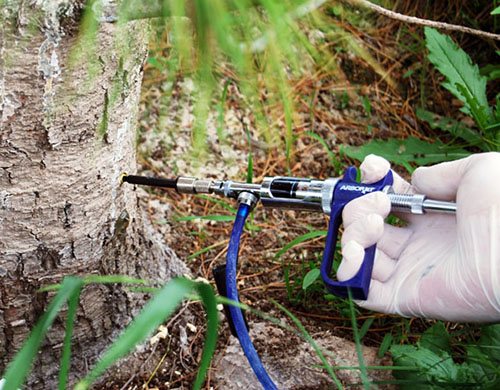

Antiferomone agents are very popular, which are pumped into the wood with a syringe. To do this, a hole is made in the trunk with a perforator, the preparation is poured into it and the hole is sealed with garden pitch. The procedure should also be carried out repeatedly - at least 2-3 times with an interval of several days.
You can help the tree fight pests on its own by feeding and regularly loosening the soil around the trunks. Remember that, by nature, the bark beetle tends to settle on weakened plants. If a tree is badly damaged by a beetle, it must be cut down and burned - while you treat it, the bark beetle will move to neighboring ones.
Pheromone traps for the garden are relevant only for large areas from 10 hectares. In this case, a small sector is treated with pheromones, and when bark beetles flock there, they simply destroy it. In this case, it is not rational to donate trees in a small garden.
Folk remedies
Folk and simple methods will become a real help when used together with chemical insecticides.
To get rid of the bark beetle is suitable:
- drying oil by impregnating wood after heating to 65 g;
- kerosene and turpentine (1x3) for processing surface layers and pouring into the holes using a conventional syringe;
- boiling water by pouring it into the holes, although there is no guarantee that the beetles will die completely and will not start making their moves again;
- dichlorvos as a popular and affordable remedy among the people also by pouring a solution into cracks, spraying branches, tree trunks.
Before treating wooden wall ceilings in a house, you need to remove the old caulk from the cracks and other sealing material so that the chemical compounds can penetrate deep inside and give more reliable results. Last but not least, all cracks, cracks should be sealed with a sealant or putty, painted with a layer of varnish, paint or garden varnish in order to prevent completely access to parasite trees.
The main types of woodworm beetle and harm from them
How to get rid of a wireworm in your garden
In a private house, even a wooden one, even a stone one, you can often find a variety of insects. Therefore, in order not to start the situation, you need to know the enemy "by sight".
Bark beetle
Bark beetles are the collective name for about 750 species of beetles. In the wild, they serve as orderlies of the forest, ridding it of old and sick trees. And in wooden houses, these half-centimeter beetles eat everything they can reach. The most common of these are the bark beetle, furniture grinder, typographer beetle and sapwood.
But the odorous woodworm, although it is similar in name to a domestic pest, in fact does not apply to them. This moth also eats wood, but only on living fruit trees, so it is unrealistic to lure it into the house.
These brown or black bugs enter the house along with contaminated building materials. Each species prefers certain types of wood, but everything goes without fish.
Grinder beetle
Black and brown grinder beetles reach 1 cm in length and move mainly at night. They are very shy and hide from people, but their presence in the house betrays a characteristic ticking sound.
In the old days, grinders were called “the hours of death”, because a few years after the appearance of this sound, the house collapsed, often burying all residents under its walls.
There are bread grinders, brownies, comb grinders and furniture grinders. They affect furniture, books, food, spices, herbariums, coniferous and deciduous trees.
Barbel beetle
The beetle, black with a green or blue tint, can be distinguished by its characteristic mustache, which is almost three times longer than the body. The beetle itself reaches 3.5 cm in length, and its larvae can live up to 15 years, making kilometer passes in the wood. They try to settle in attics or under a roof; females lay up to 400 eggs at a time. In the house, they appear with raw material even during the construction phase. There were cases when a colony of barbel made a house unsuitable for life before the rightful owners moved into it.
Regardless of the species, the beetles themselves are not dangerous for the house - it is the woodworm larvae that eat the wood, and the adults only increase their numbers.
Development in all carpenter moths proceeds according to the same scheme, only the duration of the periods of maturation differ:
- The female lays eggs in the holes or crevices of the tree.
- Larvae appear from the eggs, which feed on wood, making moves in it.
- After two weeks, the larvae move to the surface of the tree and pupate.
- After three weeks, the pupa turns into an adult beetle and flies out for further reproduction.
Although the main breeding peak for all woodworm beetles occurs in the summer, in heated non-freezing houses they are able to breed throughout the year. In this case, a colony of beetles will take three years to turn the supporting structures into dust.
Life path of the parasite
In winter, typographers sleep peacefully in the forest floor, within a 2–3 m radius around the tree on which they were hatched. In the first half of May, they get out of hiding places and scatter in search of weakened trees. It is the weak and the sick, who are not able to repel the enemy, that ate becomes easy prey for the bark beetle. Even if the plant looks healthy outwardly, the typographer will not be mistaken, he has a nose for diseased trees.
The beginning of the flight of bark beetles coincides with the time of blooming of birch buds. This is the first signal: buds are opening on the white-barrel - you know, the enemy has begun his attack. Having found a suitable tree, the beetles grind entrance holes in its bark and lay eggs under the bark. From them, larvae develop, which, feeding on living tissues of a tree, make numerous passages under the bark.
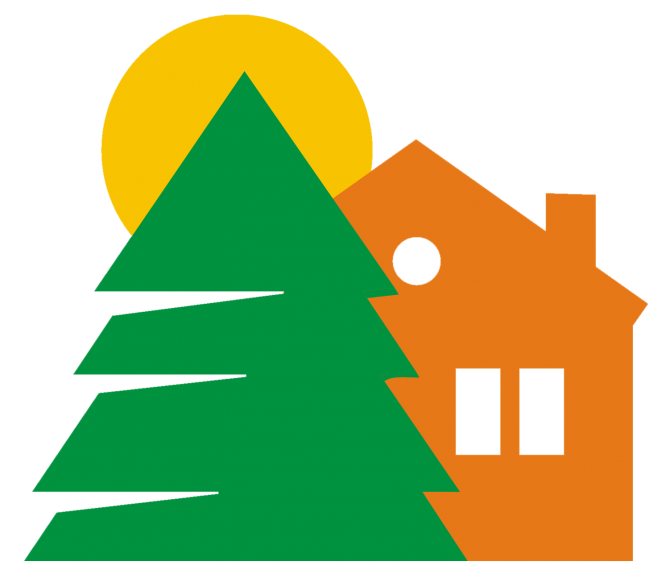

Development of offspring from larva to young beetle lasts 60–70 days. In the first decade of July, young typographers leave their parental home and found the second generation. And old beetles, having reinforced their strength with additional nutrition, lay another two or three sister generations, each of which develops 2-3 weeks later than the previous one. But in a wet and cold summer, only one generation matures.
By winter, everything returns to normal - young beetles are hiding in the forest litter around a tree worn out by them, from where they will launch a new attack on the forest next spring. But some remain to winter in the bark - these are offspring from sister generations, young undernourished, undeveloped beetles, pupae and larvae. However, most of them will not survive the winter, they will freeze out.
We suggest that you familiarize yourself with: Phone how to get rid of bedbugs
Development stages of the typographer beetle
How to get rid of mealybugs on houseplants
Analyzing the photographs, it becomes clear that this type of beetle goes through three stages in its development.
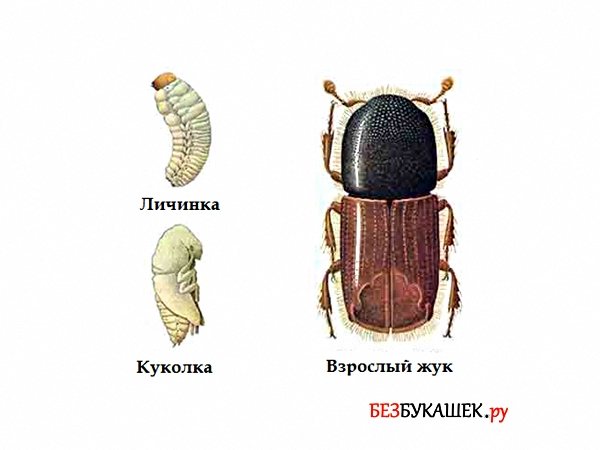

Three stages of development of the typographer beetle
Consider each:
- Larva stage. The bark beetle larva is large, has a white or slightly yellowish color. It is always slightly curved towards the abdomen; strong bulges are observed on the body, resembling tiny pads, or calluses. The larva needs them as support when it moves inside a narrow passage in the wood. The head of the larva is small, strong, brownish in color, and the body is covered with microscopic hairs. It can live inside a damaged tree from several months to a year, depending on environmental conditions.
- The pupa stage. Gradually developing, the larva turns into a pupa, which already has underdeveloped wings and legs. The head is much better developed than that of the pupa; antennae even protrude from it, reaching up to the front thighs.
- The stage of an adult beetle (imago). A sexually mature typographer has a rounded, dense brownish body with an average length of about five millimeters. In the second photo, it can be seen that its wings at the back have a characteristic depression, which allows the insect to rake off the wood dust that occurs when the beetle moves inside a narrow passage. Adult typographers fly very rarely, only during mating or in order to change their habitat if food runs out in the previous one.
Insect characteristic
Azimina planting and care, growing in the ground
The bark beetle, or the typographer, as scientists call it, can be compared to the forest Colorado potato beetle - a pair of individuals is able to multiply quickly, and the offspring will destroy everything in its path. And although the main food plant of the beetle is spruce, in its absence it does not disdain pine, fir, cedar and larch. But if such trees do not grow on your site, do not rush to rejoice, since there are several varieties of bark beetles with different gastronomic preferences.
Classification of bark beetles:
- The bark beetle is a beetle with a slightly rounded back of the body. It settles mainly in pines and very rarely in spruces. There are also large and small bark beetles. The big one settles in the lower part of the pine trunk, where the bark is thicker, and the small one - at the top.
- The bark beetle is real - you can recognize it by a kind of depression in the back of the shell on the back.
- The sapwood is a beetle whose body shape vaguely resembles a chisel (the back part is, as it were, cut obliquely). Elm species and oaks are preferred.Contributes to the development of vascular mycosis in oak trees and spreads spores of Dutch disease.
The bark beetle goes through three stages of development: from a larva it turns into a pupa, and then into an adult (imago). The easiest way is to destroy the recently laid larvae, but it is worth remembering that in some species of beetles they develop not for a year, but for two years, remaining to winter in the depths of the tree. They can withstand frost down to -30C, so often, even after the coldest winter, new individuals appear, and the cycle begins again. However, if it is an extremely hot summer, then the larvae may die - the critical temperature for them is + 40C.
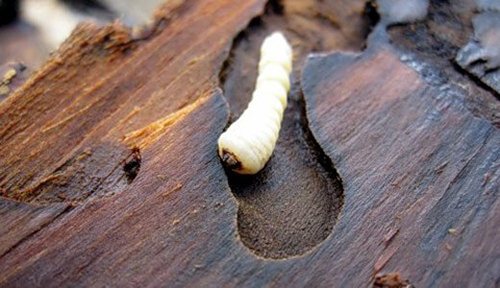

It is not surprising that the bark beetle is found mainly in countries with a temperate climate: Japan, Georgia, Russia, Korea, Ukraine. But recently, due to strong deforestation and climatic changes, the distribution area of pest beetles has greatly expanded. For example, not so long ago it was discovered in North America.
Features of behavior
Bark beetles spend almost their entire life inside a tree, arranging there real “maze cities” of gnawed passages and burrows. They fly out only when the swarming period begins or the tree has already become unsuitable for life. When a beetle hits a new tree, it immediately begins to gnaw through the channels, striving closer to the center, where the wood is softer and more juicy. There, the beetle equips the mink and lays eggs.
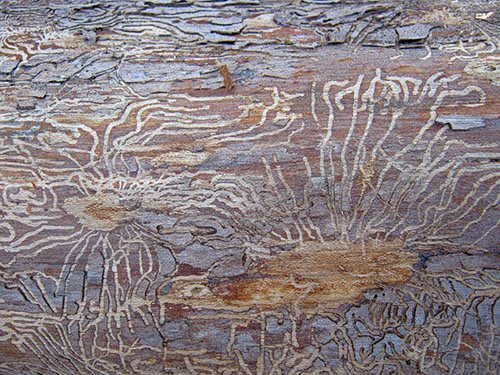

Interesting fact: Each species of bark beetle has its own "pattern" of moves. If you study this topic in detail, you can determine exactly which species settled in the tree and choose the right means to combat it.
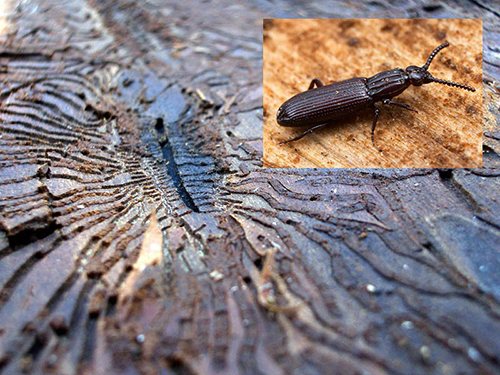

Breaking through more and more passages inside the tree, the beetles carry mushroom spores through them, which also contribute to the destruction of wood. As a result, the plant loses its ability to eat properly and dies. The most interesting and unpleasant thing is that it is almost impossible to determine the presence of a bark beetle - a tree may be “dead” for a long time, but from the outside it will seem completely healthy.
But it is strange to think that nature could have created a knowingly harmful and dangerous creature, and this idea is to some extent correct. In fact, bark beetles, like many similar insects, are the orderlies of the forest. They settle in trees weakened by caterpillars or fire, facilitating their early replacement with new shoots. But under favorable breeding conditions, the absence of natural enemies or excessive cutting down of strong large trees, the bark beetle has no choice but to spread to young plants that are unable to fight pests. And then things take a more serious turn, since the beetles become less selective and spoil garden crops.
Methods of dealing with bark beetle
At the moment, there are various ways to combat the pest, as well as remedies. Therefore, we will highlight only the most effective ones.
What will help to defeat the bark beetle:
- preparations based on chemical components;
- various traps and scarers;
- injection of trunks.
All methods are good, but they should only be used at a certain stage. Therefore, let's take a closer look at each of the techniques.
Preparations based on chemical components
Chemicals, in other words, insecticides, are distinguished by their ability to penetrate the deepest layers of the crop. Therefore, most often they resort to these substances in the fight against bark beetle. But at the same time, such processing can be performed only after flowering.
It is worth noting that experienced summer residents recommend using the following tools:
- Confidor;
- Calypso;
- Arrivo;
- Pirinex.
Important! Insecticides should only be applied after flowering has ended. As a rule, it is during this period that the main years of these individuals begin.
Therefore, before starting treatment, you can put on a protective suit or protect your skin in another convenient way.


As for the processing method, first you need to dilute any of the above means, use it strictly according to the instructions. It is necessary to spray the bark with insecticides starting from the branches, and then the trunk of crops such as pears, apple trees, as well as all neighboring trees. Then, after two weeks, the spraying must be repeated.
Traps and scarers
One of the methods of protection against attacks of the bark beetle is the capture of parasites. It is performed during the summer of the insect. And in order to catch beetles, experienced gardeners are advised to make traps out of wood.
When beetles are looking for a new home, they are guided precisely by their sense of smell. And the smell of cut wood strongly attracts them, and they begin to plant not on living crops, but on cut fragments. Well, when the summer period ends, the wood inhabited by new residents must be collected and destroyed by burning.
In addition to tree traps, you can drive the beetle out of the garden with the help of so-called antiferomone repellents. Such a remedy is sold in the form of tablets, which have a disgusting smell for the smell of the bark beetle.
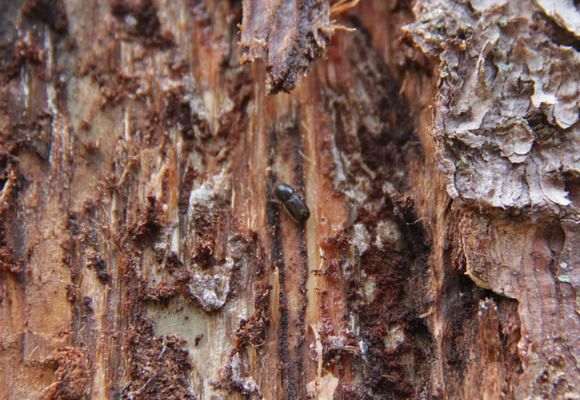

If you decide to use this particular method, then you need to purchase and decompose the tablets at least a week before the beginning of the insect's summer.
Today there are so-called pheromone traps, but they are intended for gardens with an area of at least 5 hectares. Well, as for private front gardens, then such funds will not be of use.
The main advantage of all the above means is that they are completely harmless to the environment and to the health of the person himself. But you need to use them only before the beginning of summer. Otherwise, there will be no positive result.
Barrel injection
Spraying with insecticides, the use of traps - all this gives an effect only if the bark beetle has not yet penetrated deep into the wood of the tree. But if the individuals still managed to penetrate, then it can be overcome only with the use of extrusion of the barrel part.
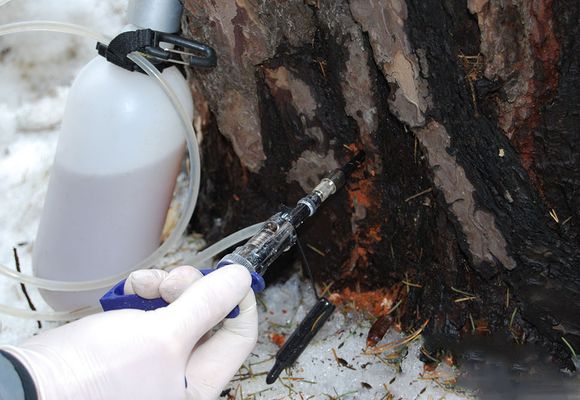

This technique is very effective and efficient. Moreover, sometimes it is possible to save a tree trunk only by using extrusion.
Such a manipulation is performed by inserting it into the holes made by the bark beetle. As a rule, the following drugs are used for such purposes:
- Confidor;
- Tanrek.
If you plan to do injection, then you need to dilute the preparations so that the solution is highly concentrated. Well, after you carry out this manipulation, do not forget to grease the trunks with lard or margarine, with the help of which the bark beetle larvae are completely destroyed. And do not forget to regularly inspect the plant during this period.
Folk methods
There are a lot of folk ways, but we will consider only one recipe that can really be used, since it helps well to cope with beetles. So, for processing a tree immediately after flowering, you will need to stock up on the following tools:
- 6 liters of warm, settled water;
- 2.5 cups of laundry soap, pre-grated on a fine grater;
- 2.5 cups carbolic acid.
We thoroughly dissolve all the components in warm water, then dilute the finished solution in 15 liters of water, and thoroughly spray the culture with the finished product. After a week, the treatment must be repeated. Since the culture may still contain parasites that survived after the first treatment.
Preventive measures
It is very difficult to deal with woodworms, so it is much easier to prevent their appearance. To prevent beetles from infecting trees, you need to follow these recommendations:
- It is much easier to inspect plants regularly, since it is much easier to eliminate parasites that have just appeared than to deal with numerous colonies.
- Cover the bark of trees with special compounds.Suitable drugs like "Lepidacid", "Bitoxibacillin" or "Boverin".
- It is advisable to treat seedlings before planting with insecticides or a homemade mixture. To prepare it, you need to mix half a bucket of water with a liter of liquid soap and 2 glasses of crude carbolic acid. The resulting solution must be diluted with water in a ratio of 1:25. It can also be used to treat mature trees.
- Monitor the condition of the soil. It should be moderately moist and fertilized, it is advisable to periodically loosen the soil around the trees.
- Clean the plants regularly, cutting off excess shoots from them.
- Carry out preventive treatment with a mixture of slaked lime and manure, combined in equal quantities. This product should be applied in a thin layer to the bark of the tree.
To prevent the infection of buildings with bark beetle, it should be remembered that these pests feed not on the wood itself, but on its sap, therefore, the drier the material, the less the risk of parasites in it. You should choose high-quality and well-dried boards or beams. You can check them as follows: you need to drop a little iodine on the selected material. Fresh wood will turn blue, and on dry wood, iodine will retain its hue.
In addition, when choosing a material, you should carefully examine it, paying attention to each crack. Female beetles can lay eggs in these holes.
If there is yellow dust in the cracks, then the wood is affected by the bark beetle. In this case, it is worth choosing building materials from another contractor, and not in a nearby store, since there is a possibility that the goods there will also be contaminated.
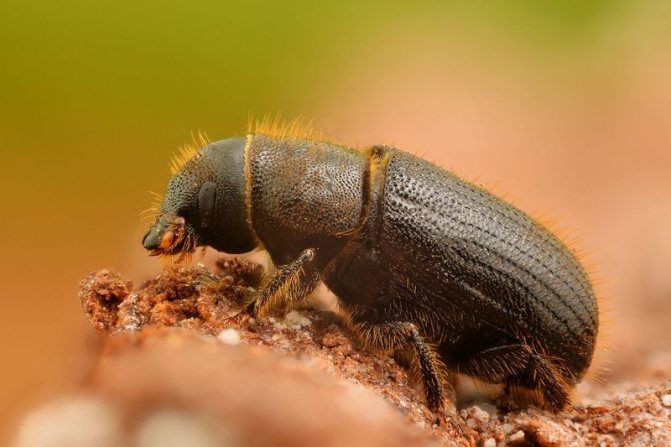

When buying a wild log house covered with bark, it is rather difficult to see the pest moves, however, it is possible. To do this, it is worth carefully examining the ends of the selected logs. They should be free of debris and small holes.
By following these simple recommendations, you can save your garden and home from the invasion of bark beetles. If the beetles are still wound up, it is worthwhile to immediately begin to destroy them, without postponing this task for the future.
How do professionals work?
Unlike household garden sprayers used by summer residents, the sanitary and epidemiological station specialists have at their disposal special technical means - fog generators that can provide an intense effect on bark beetles at any stage of their development. And you don't have to move furniture, disassemble the wall section. Fumigation will allow you to get to the pest wherever he is hiding.
Feedback: We encountered a bark beetle in a wooden country house. At first, the rustles were not troublesome. And then the husband began to hang the shelf, and the wall was literally all in holes. They began to examine carefully, realized that we could not cope ourselves - the beetle had done so many moves that it was too late to cut it out in pieces. I had to call specialists. And then the repeated processing of the house from the bark beetle was needed to finish everyone off.
- Destruction of the bark beetle in the house
- Treatment of the area from insects
- Treatment of a summer cottage from mosquitoes
- Destruction and treatment of the area from ticks
About the bark beetle typographer
Botanists distinguish more than one species of bark beetles among beetles, they live in different natural conditions and sometimes look different. But in temperate climates, the most common is the lover of conifers, also called the typographer beetle. This name of the bark beetle can be easily explained: it and its larvae leave characteristic traces under the bark of the tree and inside the wood, reminiscent of a bizarre typographic print on tracing paper.
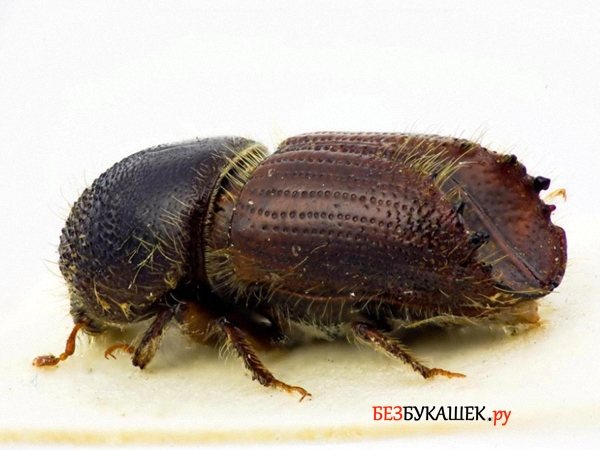

This is what a typographer beetle looks like.
What the bark beetle and its larva look like, as well as the nature of the damage they inflict on wood, is clearly demonstrated by the following photos.
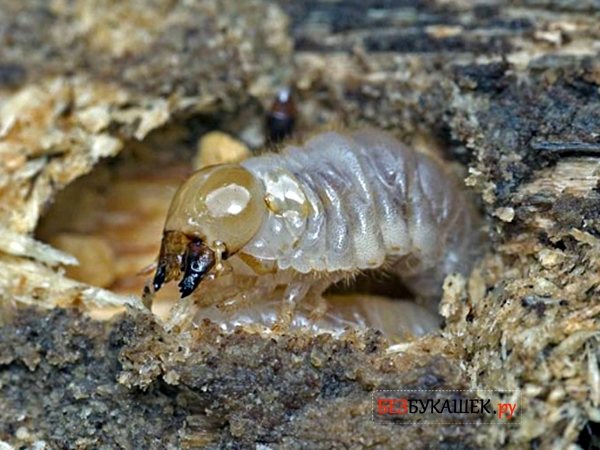

This is what the larva of a typographer beetle looks like (bark beetle)
Each beetle has its own characteristic pattern, which it leaves inside the tree.Experts, using this pattern, easily determine which of the types of pests lives in a given tree. In the future, this helps in the fight against insects.
Causes and signs of appearance
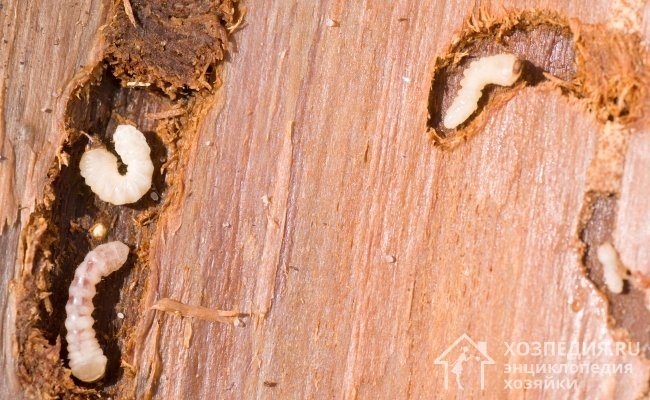

The main reasons for the appearance of bark beetles in wooden houses:
- high humidity, which leads to damage to wood by a fungus;
- improper or insufficient wood processing;
- use of low-quality materials for construction;
- purchasing wood furniture made from contaminated wood.
It is almost impossible to identify pests in a residential area, since they settle deep in the wood, and creep out only when the raw materials become unsuitable for life and nutrition. However, if you are careful, you can see the first signs of pests. A careful examination reveals small holes (up to 2 mm in diameter) and the remains of brown flour (processed wood), and a rustle is heard at night.
In the garden, a visual inspection of the trees will help to determine the presence of pests - they begin to dry, and under the bark you can see the moves of the grinder. You can see how it looks in the photo below.
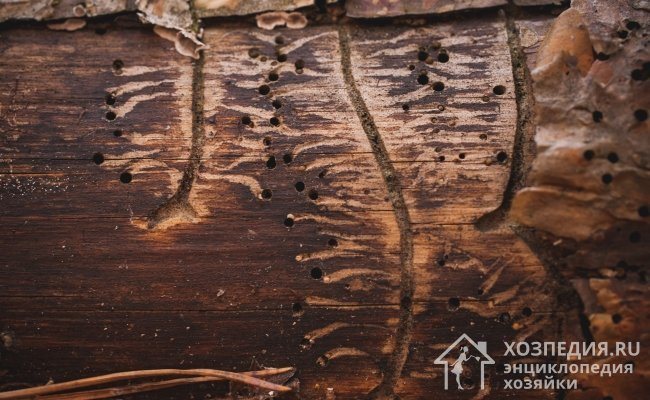

The appearance of bark beetles is indicated by the presence of small holes and passages that can be seen under the bark of trees or on affected wooden products
Mechanical pest control
A radical method will help to get rid of the bark beetle - dismantling and burning the affected wood. This method is used in exceptional cases, since it has a number of disadvantages:
- damage to the integrity of wooden structures is required;
- it is impossible to be absolutely sure that the other elements of the structure are not affected by pests;
- effective only at the initial stage of reproduction of bark beetles.
Fumigation
Fumigation using phosphine or magtoxin gases will help to cope with pests. Poisonous gas enters the passages of insects, destroying eggs, larvae, pupae and adults. Carrying out gassing should be entrusted to specialists in order to achieve maximum results in the fight against parasites, to avoid poisoning and other negative consequences.
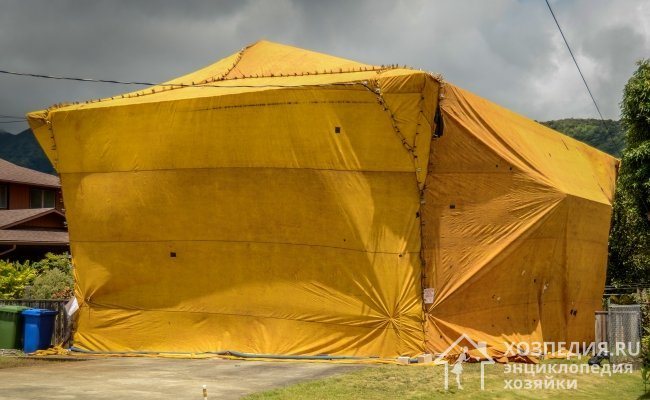

During fumigation, a wooden house is covered from the outside with a special dome, which prevents the spread of gas over the area and increases the efficiency of processing the structure
Disadvantages of fumigation:
- high price;
- the need to attract specialists;
- high toxicity of the gas used;
- after baiting, degassing is required so that the phosphine particles disintegrate.
Pheromone trap
Mechanical methods of action include a pheromone trap. This biological method is environmentally friendly, safe for people and animals. The trap is a plastic structure with a pheromone inside. The beetles flock to the attractive aroma, hit the partition and fall to the bottom of the container, from where they cannot get out. The principle of operation of the pheromone trap is described in detail in the video:
Microwave devices
Devices emitting high-frequency electromagnetic waves will help fight pests in a wooden house. The microwave emitter heats the wood to high temperatures (+60 ℃), which effectively destroys insects at different stages of development. This method is safe for the building and residents, however, it requires compliance with certain safety measures, so it is better to entrust the work to specialists.
Prevention of trees
Timely measures taken to prevent the appearance of the bark beetle will help protect the tree from pest infestation. There are many such actions, and they depend on whether this should be done in forest plantations or in a house:
- Cracks, wounds, holes in the bark are closed with garden pitch.
- Coat the tree trunk with a mixture of humus and clay, thereby creating a barrier for beetles.
- Damaged leaves are burned and the trunk circle is deeply dug in.
- They take care of the trees according to all the rules so that the plantings are healthy and strong.
- An annual preventive treatment of trees with chemicals or a mixture of manure and slaked lime is carried out.
- Wood material intended for building a house or making furniture is carefully dried, ventilated, impregnated with a special compound against bark beetles.
Preventive measures against the attack of bark beetles are a necessary concern for protecting the environment and improving human living conditions.
Who is the bark beetle or the enemy you need to know by sight
The bark beetle is a small beetle that lives, reproduces in wood and eats only wood. There are more than seven hundred species of bark beetle in the world, one hundred and forty of them can be found in European countries. Most often, bark beetles affect coniferous trees (spruce, pine, fir, cedar, etc.), but there are types of bark beetles that like deciduous trees. The bark beetle can infect both a living tree in a forest or garden, and wooden buildings, furniture, harvested timber. The maximum size of the bark beetle is 8 millimeters, but there are individuals and smaller from one millimeter.
The life cycle of the bark beetle consists of several stages:


- fertilization of the female,
- laying eggs,
- the appearance of larvae,
- the transformation of larvae into pupae and the emergence of an adult beetle. Then everything is repeated. At a time, the female is able to lay up to one hundred eggs, which in two weeks will turn into larvae, in one season the bark beetles are able to triple their numbers. The bark beetle larvae that did not have time to turn into an adult representative can overwinter in the bark and continue the cycle next year. As for the weather conditions, the bark beetles perfectly tolerate heat up to forty degrees and severe frosts. Only temperatures below thirty degrees are capable of killing beetle larvae.
Bark beetle photo and description of the main species
What does a bark beetle look like? Although there are a great many species of this insect, there are the most popular and widespread species in large areas. Types of bark beetle: - typographer beetle. Lover of conifers.
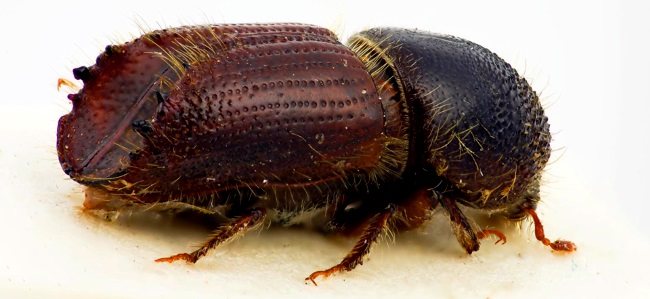

- beetle grinder. This bark beetle does not specialize in living wood, but in wood and affects houses made of wood, furniture, etc.
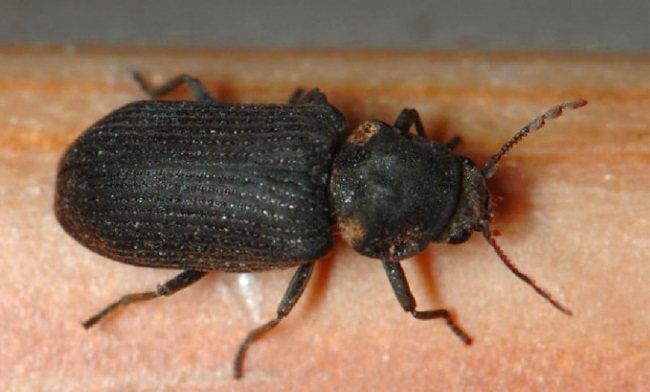

- bark beetle. It is very common in Taiga. It can fly over short distances, thereby hitting more and more new territories.
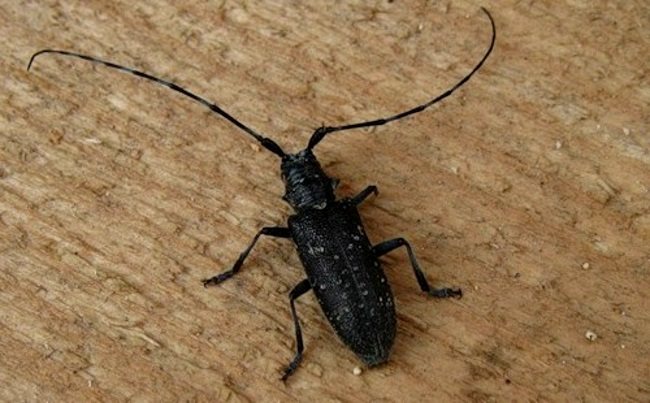

- birch sapwood. This bark beetle specializes in deciduous species.
